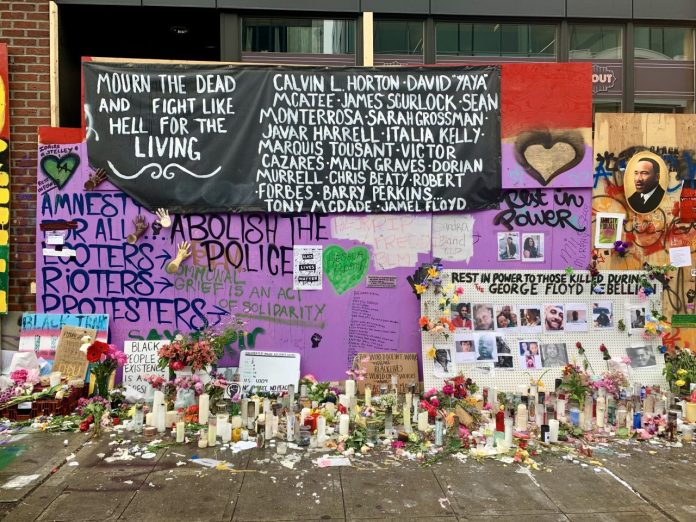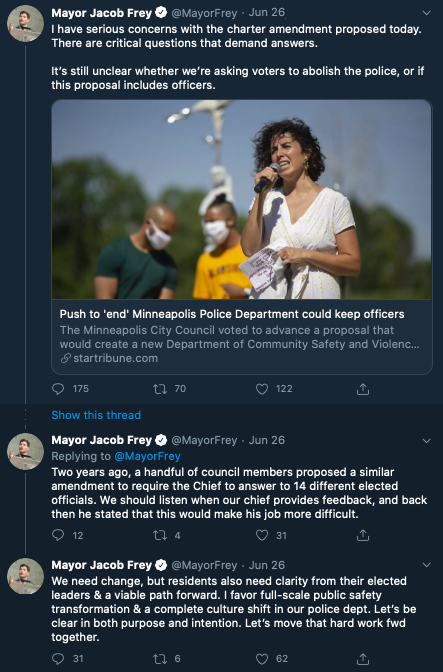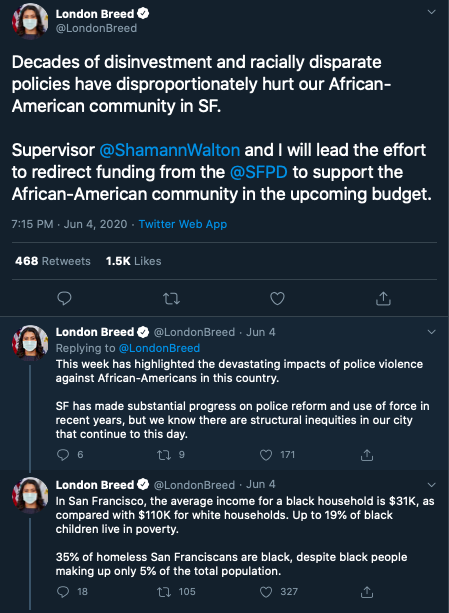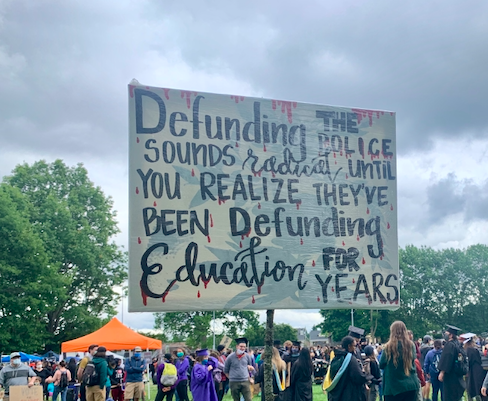
Against the backdrop of national discussion around how to reimagine public safety in the United States, Seattle’s local government leaders have been moving forward with promises to reduce the Seattle Police Department (SPD) budget, although significant disagreement exists over how much funding should be removed. While four Seattle City Councilmembers so far have called for SPD budget reductions of 50%, Mayor Jenny Durkan has currently proposed cutting only 5% from SPD’s budget, which was approximately $410 million in 2020. She has also vowed to share with the public budget scenarios that would represent what reductions of 20%, 30%, and 50% would look like.
A strong contingent of the Seattle City Council, however, seems ready to push back against cuts that fall so far short of protesters’ demands. “It has been resoundingly said by our council here that we are prepared to respond to the community organizations that are Black-led and leaders around the nation to adopt policies and procedures that reduce budgets to actually transform our system here,” said Councilmember Teresa Mosqueda at a recent Select Budget Committee meeting.
For Seattle officials, the clock is ticking. Budget discussions are already underway, and negotiations will need to become increasingly specific in the near future. While coming to agreement on exactly how much the SPD should be defunded is sure to hold the public’s attention, the specific changes that will result from those cuts will also be significant and many questions remain unanswered.
To get a better insight on how these conversations are playing out in other cities, Seattle officials received updates during the same Budget Committee meeting on plans to defund and reform police departments from city councilmembers and staff in Minneapolis, New York City, and San Francisco–all cities that are also struggling with their own unique pressures and challenges around policing and public safety.
What can Seattle learn from other cities?
Like Seattle, many cities are also making major budget decisions for the next fiscal year on a short timeline, elevating the sense of urgency. Some other cities also face additional hurdles that could stymy progress. Such is the case in Minneapolis where the death of George Floyd at the hands of police sparked nationwide outcry–but where activists had been sounding the alarm for years without much headway.
Despite a progressive reputation, police brutality has been a contentious topic in Minneapolis for a long time and systems have been slow to change. “The idea of defunding the police isn’t new. A number of us on the City Council try to do it every year and we’re unsuccessful,” said Minneapolis City Councilmember Jeremiah Ellison, who was active in community organizing for police accountability before holding elected office. “But I think this has took what was a fringe idea last budget cycle and woken people up to the fact that we really need to do something about how we keep people safe because this model of safety really has failed.”
Although Minneapolis gained national attention when its city council voted to abolish its police force and replace it with a department of public safety, the city is facing its own hurdles in terms of making the vote a reality. Mayor Jacob Frey has been unwilling to support defunding and called instead for reforms to the existing department. And until a city charter which requires funding for the police force is either struck down or amended, the city council may be unable to move forward with its plans.
Changing the charter will require unanimous city council approval plus the support of the mayor, which seems unlikely to happen. The charter could also be changed by citywide vote or by a decision cast by the current city charter commission, both options that are not currently moving forward. So for now, discussions about how much to cut off Minneapolis’s police funding have hit a roadblock.

By contrast, in New York City cuts to police department spending have gained momentum. Mayor Bill de Blasio recently agreed to support the New York City Council’s call to reduce the city police budget by $1 billion from the department’s $6 billion budget, an announcement that came on the heels of a weekend of gun violence in New York City which resulted in 11 people being shot.
“I’m excited to say we have a plan that can achieve real reform, that can achieve real redistribution–while at the same time ensure that we keep our city safe, while we make sure that our officers are on patrol around where we need them around this city,” said de Blasio in an New York Post article, in which representatives from both sides of the political aisle also weighed in with their concerns about the amount and nature of the pending budget reduction.
At about 17%, New York City’s cuts are steeper than those committed to by other major cities including Los Angeles, which is seeking to remove $100 million to $150 million from its $1.86 billion police budget, a significant shift from just last April when Mayor Eric Garcetti had proposed increasing the police budget by 5%. In Chicago, Mayor Lori Lightfoot has argued against defunding the police force, despite some pressures from the public protesters and city aldermen calling for police funding to be diverted into programs that serve low-income communities in the south and west sides of the city.
In San Francisco, Mayor London Breed and Supervisor (councilmember) Sherman Walton have called for what local NPR station KQED describes as an “unspecified amount of funding” from police department’s budget to be reallocated to support programs in the city’s African-American community as “a reparation for city polices that led to ‘decades of disinvestment.'”

In the meeting with the Seattle City Councilmembers, Tracy Gallardo, a staff member for Supervisor Walton, said the goal would be to cut $100 million from its current $700 million police budget, but did not specify how much of that funding would be invested in reparations. Still, both Gallardo and Walton spoke passionately about the need for reparations in a city struggling with deep racial and economic inequality. “We are making sure that we achieve full reparations because this is what [defunding the police] is leading to,” said Walton in the briefing to the Seattle City Councilmembers.
Replacing armed police officers with trained unarmed professionals as first responders for noncriminal calls is one concrete step toward reform that has been recently taken by San Francisco. Mayor Breed has also announced that she has directed the San Francisco Police Department to establish a policy banning the use of military-grade weapons against unarmed civilians, including chemical weapons, such as tear gas, as well as bayonets or tanks. The city would also have get rid of military-grade weapons by the end of 2021. Finally, police hirings and promotions will be audited by the city’s human resources department with a focus on testing candidates for bias and potential for abuse of force.
Police defunding leads cities into uncharted waters
A sense of cautious optimism was a common thread among the updates from different cities, despite the individual and shared challenges faced. But a lot of details around what it will look like to defund city polices forces remain undecided, making the future unclear.
“Nobody has quite done what the is community calling for, but there are processes in place and strategies that are being discussed right now to demand or respond to the action,” said Councilmember Mosqueda, who ended the meeting with a call for Seattle leaders to “listen, then act.”

Zeroing in on a specific amount to defund from the SPD budget promises to be a first step and protesters’ demands around this topic have varied. Mosqueda, along with Councilmembers Kshama Sawant, Tammy Morales, and M. Lorena González have called for a budget of 50% this year, a percentage that goes deeper than what other major cities seem to be seriously considering. While a broad coalition of social justice groups under the banner Decriminalize Seattle back the 50% cut, Black Lives Matter of Seattle-King County has called for a $100 million reduction, which is about half that much, among other calls for reform.
However, as the SPD budget comes under more public scrutiny, cutting funding for specific expenditures, such as the presence of armed police officers on Seattle’s Navigation Teams, which provide outreach to people who are homeless, might gain attention. Additionally, recent events, such as the shooting of two teenage boys who may haven involved in a drive-by shooting, one of whom was killed, in the Capitol Hill Organized Protest (CHOP) Zone, the fourth shooting and second death to have occurred in ten days, may also impact upcoming discussions around diverting funding from SPD to other city programs and services that promote public safety.
Natalie Bicknell Argerious (she/her) is a reporter and podcast host at The Urbanist. She previously served as managing editor. A passionate urban explorer since childhood, she loves learning how to make cities more inclusive, vibrant, and environmentally resilient. You can often find her wandering around Seattle's Central District and Capitol Hill with her dogs and cat. Email her at natalie [at] theurbanist [dot] org.


